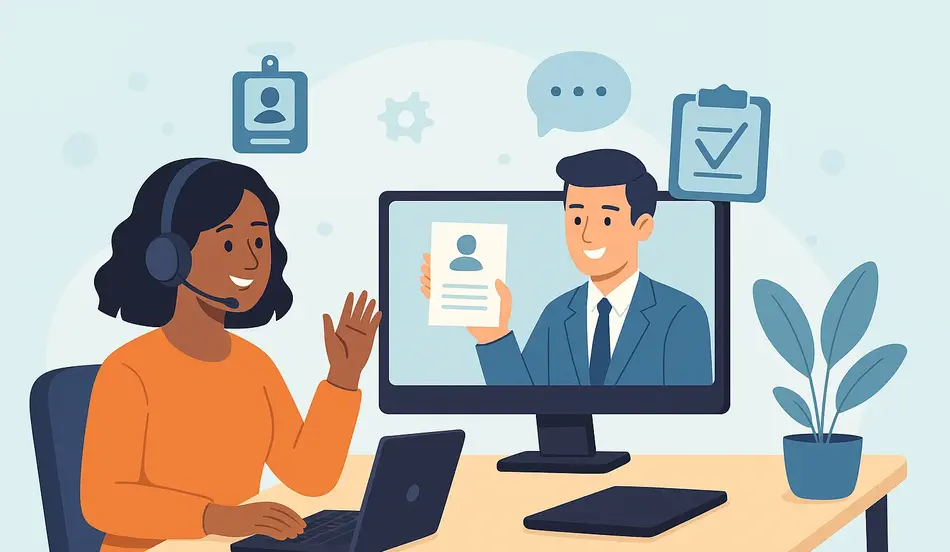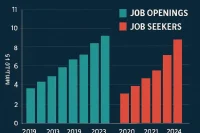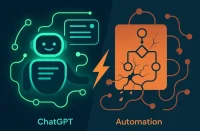As remote and hybrid work models become permanent fixtures in 2025, the first few weeks on a new team often happen entirely online. Virtual onboarding—the process of integrating new employees into culture, tools, and workflows remotely—can determine engagement, productivity, and long-term retention. Done well, it accelerates time-to-contribution; done poorly, it leaves hires confused, disconnected, and at greater risk of early turnover.
This guide covers proven practices for designing and delivering a seamless virtual onboarding experience that sets remote employees up for success.
Start Before Day One
Pre-Boarding Welcome Package
The moment a candidate accepts an offer, begin the engagement:
- Welcome Email & Portal Access
Send a personalized email linking to a pre-boarding portal. Populate it with company values, organizational charts, and video messages from executives. - Swag & Gift Delivery
Ship company-branded items—mugs, notebooks, even a small plant—to the new hire’s home. This tangible welcome builds excitement and connection. - Technical Readiness
Confirm shipping of hardware (laptop, headset) and send clear setup instructions. Offer a scheduled “IT onboarding call” to resolve any access or connectivity issues before Day One.
Culture Primer & Community Introduction
Give hires a head start on cultural immersion:
- Short Culture Videos
Two- to three-minute clips highlighting mission, team traditions, and success stories. - Virtual Office Tour
A short video or interactive map showing core collaboration spaces—Slack channels, intranet hubs, knowledge bases, and social groups. - Introduction in Team Channels
Post a friendly introduction from HR in channels like #new-hires and #general, encouraging colleagues to welcome the newcomer.
Structured First-Week Plan
A purposefully curated first week helps remote hires build confidence quickly.
Day-One Kickoff (90 Minutes)
- HR Overview: Benefits, payroll, policies, and organizational structure.
- Leadership Welcome: A live or recorded address from the CEO or founder, sharing vision and values.
- Live Q&A & Icebreakers: Short breakout rooms or polls to let new hires share backgrounds and fun facts.
Role-Specific Orientation
- Manager One-on-One: Clarify immediate priorities, success metrics, and communication preferences.
- Team Meet-and-Greets: Ten-minute chats scheduled with direct collaborators, using “calendar invites with video links.”
- Sandboxes & Shadowing: Access to a staging environment for safe exploration of systems; pairing with an experienced peer for task walkthroughs.
Daily Check-Ins
- Manager Touchpoint (15 minutes): Discuss questions, adjust expectations, and maintain open lines.
- Buddy Check (10 minutes): Informal chat with an assigned “onboarding buddy” to address cultural and process queries.
Assign a Dedicated Onboarding Buddy
Pairing new hires with peers fosters belonging and informal knowledge sharing.
Buddy Selection & Training
- Buddy Criteria: Choose someone 1–2 levels above entry, with strong interpersonal skills and a track record of patience.
- Buddy Responsibilities: Answer day-to-day questions, introduce social norms, and host weekly “virtual coffee” catch-ups.
- Formal Training: Provide buddies with conversation guides, suggested check-in cadences, and escalation paths for unresolved issues.
Social Connection Rituals
- Virtual Coffee Roulette: Automate random, 15-minute pairings across departments, building networks beyond immediate teams.
- Shared Interest Rooms: Slack channels like #book-club or #gaming for non-work bonding, with invites for new hires from day one.
Leverage Collaborative Technology
Centralized Onboarding Hub
Maintain a single source of truth for all onboarding resources:
- Learning Management System (LMS): Courses on tools, policies, and role-specific skills.
- Knowledge Base: Confluence or SharePoint wiki with step-by-step guides, policy documents, and FAQs.
- Video Library: Short, searchable clips of system demos, culture stories, and past onboarding sessions.
Real-Time Communication
- Dedicated Channels: #onboarding-questions for HR, #it-support for tech issues, and #team-intros for team socials.
- Virtual Office Hours: Block daily 30-minute slots for drop-in support from HR or IT.
Interactive Learning
- Simulations & Sandboxes: Hands-on exercises in replicable, resettable environments for core tools (CRM, ticketing systems).
- Gamified Quizzes: Embed progress-tracking questions and reward badges for completing modules, boosting engagement and retention.
Craft a 30-60-90-Day Roadmap
A transparent progression plan aligns expectations and milestones.
- 30-Day Goals: Master core tools, complete mandatory compliance training, deliver first small task.
- 60-Day Goals: Own a segment of a project, contribute in meetings, identify a process improvement.
- 90-Day Goals: Lead a minor initiative, present findings to stakeholders, mentor newer peers.
Share this plan in a collaborative document (Google Doc or Notion) and review it in bi-weekly manager meetings.
Blend Live and Asynchronous Learning
- Live, Interactive Sessions: Instructor-led workshops, panel discussions with senior leaders, and cross-department “lunch-and-learn” events.
- Asynchronous Modules: Pre-recorded tutorials, reading materials, and self-paced assignments accessible anytime.
- On-Demand Office Hours: Weekly open slots for drop-in chats with HR, IT, or managers to address blockers without formal scheduling.
Foster Early Social Connection
Creating emotional ties combats isolation and builds trust.
- Icebreaker Activities: Quick polls, two-truths-and-a-lie, or “show your workspace” photo sharing to spark conversation.
- Peer Learning Circles: Groups of 3–5 new hires who meet weekly to compare notes, share challenges, and support one another.
- Team Social Events: Virtual game nights, happy hours, or themed trivia that include both new and tenured employees to strengthen bonds.
Measuring Onboarding Effectiveness
Quantitative metrics drive continuous improvement:
| Metric | Measurement & Goal |
|---|---|
| Time to Productivity | Days until first billable/project delivery; target < 30 days |
| Onboarding Satisfaction (NPS) | New hire Net Promoter Score at 30 & 90 days; aim ≥ +30 |
| First-Year Retention Rate | Percentage of new hires still with company at 12 months; benchmark ≥ 85% |
| Training Completion Rate | Percentage completing mandatory modules within 14 days; target 100% |
| Buddy Engagement | ≥ 5 buddy check-ins in first 60 days |
Collect feedback via pulse surveys (after first week, first month, and first quarter) and adjust programs accordingly.
Maintain Momentum Beyond Three Months
Onboarding doesn’t end at 90 days—sustain growth:
- Ongoing Learning: Curate role-based learning paths through LinkedIn Learning, Coursera, or in-house workshops.
- Peer Mentoring Circles: Transition buddies into mentors for quarterly check-ins and professional development planning.
- Cross-Functional Rotations: Offer short rotations or shadowing opportunities in adjacent teams to build broader organizational empathy and skill diversity.
Addressing Common Pitfalls
- Information Overload
Avoid bombarding new hires with endless slides and policies. Pace content delivery and use summary “quick cards” for key takeaways. - One-Size-Fits-All Programs
Tailor onboarding tracks for different roles, levels, and backgrounds. A software engineer’s journey differs from that of a sales associate. - Insufficient Social Integration
Don’t neglect relational onboarding. Schedule structured social touchpoints just as you do technical trainings. - Infrequent Feedback Loops
Weekly check-ins early on prevent small issues from escalating. Encourage open dialogue and anonymous suggestions.
Smart Hiring Starts with Better Onboarding
From avoiding info overload to building feedback loops, great onboarding begins with great hires. WhatJobs helps you attract talent ready to thrive from day one.
Post a Job for FreeTechnology Stack Recommendations
- Learning Management: Lessonly, Docebo, or Workday Learning for structured courses.
- Knowledge Base: Confluence, SharePoint, or Guru for searchable documentation.
- Collaboration: Slack or Microsoft Teams integrated with Zoom for seamless chat and video.
- Survey & Feedback: Culture Amp, 15Five, or Officevibe for pulse surveys and sentiment tracking.
- Onboarding Workflow: Talmundo or Enboarder for automated task tracking and reminders.
Expert Insights
“Successful virtual onboarding is not about replicating in-person processes online; it’s about reimagining them for digital natives,” says Priya Shah, Head of People Operations at Innovatech. “Focus on meaningful touchpoints, micro-learning, and building social capital through virtual communities.”
According to a 2024 Gallup study, employees who report excellent onboarding experiences have 2.5 times higher engagement and 58% lower turnover in their first year.
FAQs
Q: How long should virtual onboarding last?
A: While formal orientation typically spans two to four weeks, a comprehensive plan—covering training, mentorship, and check-ins—should extend across the first 90 days to ensure full integration.
Q: Can virtual onboarding work for global teams?
A: Absolutely. Use asynchronous content for time-zone flexibility, rotate live sessions to accommodate different regions, and maintain a centralized hub accessible 24/7.
Q: How do I keep remote hires engaged long term?
A: Blend hands-on projects with interactive learning, social rituals (virtual coffee, gaming), and clear career pathways so employees see progress and purpose.
Q: What’s the best way to measure onboarding success?
A: Combine quantitative metrics (time to productivity, NPS scores, retention rates) with qualitative feedback (focus groups, one-on-one interviews) for a holistic view.
Final Thoughts
Effective virtual onboarding is far more than a digital checklist—it’s an orchestrated experience that shapes an employee’s perception of your culture, clarity of their role, and connection to colleagues. By starting early, structuring learning, cultivating social bonds, and measuring outcomes, organizations can accelerate remote hires’ path to productivity and belonging.
In 2025’s distributed work world, mastering virtual onboarding isn’t optional—it’s essential to attract, engage, and retain the talent that will drive your next chapter of growth.




